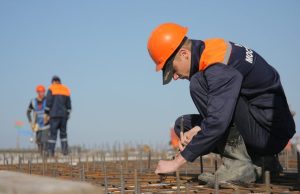The US Factory Highlighting the Paradox in Trump’s Economics
In the arid landscape of Arizona, just outside Phoenix, a remarkable facility is rising that may fundamentally impact the global economy. This construction site is not just a factory; it is poised to become a leading producer of the world’s most advanced semiconductors. Touted as a significant shift in US manufacturing, the facility is the brainchild of the Taiwanese conglomerate TSMC (Taiwan Semiconductor Manufacturing Company), which intends to invest billions in domestic production to mitigate the risks associated with tariffs on imported chips.
TSMC accounts for a staggering 90% of the world’s advanced semiconductor production. Previously, all of its intricate chips were produced in Taiwan, a short distance from the Chinese coast. Chips powering various technologies, from Apple’s iPhones to the Nvidia processors crucial for modern AI applications, all originate from this semiconductor titan.
A Close-Knit Operation
Access to TSMC’s Arizona facility, known as “Fab 21”, is tightly controlled. Security measures ensure that no electronic devices or unapproved materials enter the site, safeguarding critical designs. The manufacturing processes involved are complex and demand extraordinary precision and expertise. The facility is regarded as one of the most advanced manufacturing plants globally, reflecting TSMC’s commitment to intellectual property protection, a necessity given its relationships with tech giants like Apple and Nvidia.
Political Implications
Former President Trump frequently cites the Arizona factory as a key achievement of his America First economic agenda. Trump has asserted that shifting production back to the US is essential for reviving the country’s standing in the semiconductor industry, which he claims has been diminished primarily due to Taiwan’s dominance. TSMC’s plans to invest an additional $100 billion in its Arizona site align with Trump’s views on tariffs and economic protectionism.
The Global Supply Chain Equation
China’s government is closely monitoring the developments at TSMC. The island’s semiconductor industry has historically served as a strategic asset, known as Taiwan’s “Silicon Shield”, in the face of potential geopolitical threats. The pandemic has illuminated vulnerabilities in global supply chains, prompting countries to reconsider over-reliance on any single nation for critical technologies.
Engineering Excellence
During a recent tour of the factory, Greg Jackson, a facility manager, elaborated on the operational complexity. “It’s astonishing how tiny these chips are, yet they require an enormous facility and extensive infrastructure for production,” he remarked.
To create these advanced microchips, workers must adhere to rigorous protocols. Dressing in protective gowns and following strict cleanliness regulations ensures that the environment remains free from contaminants, which could otherwise disqualify the entire production batch. As Konstantinos Ninios, an engineer at TSMC, demonstrated, the initial productions involved layers of finely crafted silicon wafers featuring cutting-edge 4-nanometre technology.
| Feature | Description |
|---|---|
| Company | TSMC (Taiwan Semiconductor Manufacturing Company) |
| Location | Arizona, USA |
| Investment | $100 billion in Arizona facilities |
| Key Products | 4-nanometre chips |
| Market Share | 90% of advanced semiconductor fabrication |
Complexity in Global Dynamics
While the Taiwanese government is cautious about transferring its manufacturing capabilities, the reality is that TSMC’s expansion reflects a response to broader economic strategies and pressures within the geopolitical landscape. Former President Trump credits his administration’s policies for facilitating this transition of manufacturing back to the U.S., while TSMC leaders maintain that much of the groundwork was laid during the Biden administration’s Chips Act.
In summary, TSMC’s Arizona factory symbolizes the intricate interplay of technology, economics, and international relations. As the world grapples with the complex narratives of globalization, this facility represents a critical juncture in the quest for technological supremacy, particularly against the backdrop of U.S.-China tensions. The path forward remains uncertain, but the success of TSMC may prove pivotal in shaping global semiconductor manufacturing for years to come.













